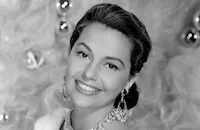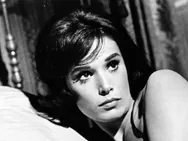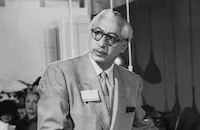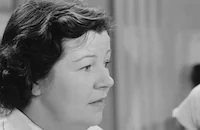Party Girl

Brief Synopsis
Cast & Crew
Nicholas Ray
Robert Taylor
Cyd Charisse
Lee J. Cobb
John Ireland
Kent Smith
Film Details
Technical Specs

Synopsis
In the Chicago nightclub the Golden Rooster, owned by mobster Rico Angelo, the mobster's henchman offers each show girl a hundred dollars to attend Rico's party that evening. Dancer Vicki Gaye scoffs at the invitation, but when her roommate, Joy Hampton, admits that she is returning to their apartment to wait for a call from her married boyfriend, Vicki decides to go to Rico's party. After receiving her hundred dollars, Vicki indifferently accompanies gangster Louis Canetto, who gives her four hundred dollars from his gambling winnings. Later in an effort to rid herself of Canetto, Vicki asks attorney Thomas Farrell to escort her home. Although Tommy uses a cane and has a pronounced limp, Vicki is startled when Canetto defers to him. During the drive home, Tommy cynically remarks about Vicki's accepting Canetto's money and reveals that he is defending Canetto against a murder charge. Back at her apartment, Vicki discovers that, despondent over her boyfriend's rejection, Joy has committed suicide. At the police station, Vicki is questioned when Joy's autopsy reveals she was pregnant, but she refuses to name Joy's boyfriend. Tommy then intervenes and takes the exhausted Vicki to his apartment to rest. The following day, Tommy asks Rico to increase Vicki's salary and provide her a better spot in the show, but not to mention his name. Several days later, Vicki visits Tommy at his office to thank him for helping with Joy's case, then asks him to return the money to Canetto. Tommy criticizes Vicki's gesture as an attempt to buy back her pride. Later that week, Vicki attends Canetto's trial to watch Tommy's closing argument. By playing up his limp, Tommy wins the sympathy of the jury and Canetto is acquitted. Vicki seeks Tommy out at a speakeasy afterward, to accuse him of hypocrisy and shameless manipulation for a price. Stung, Tommy nevertheless begins attending the Golden Rooster shows nightly, until Vicki at last agrees to see him. Tommy reveals that he suffered a childhood accident and the subsequent hip surgery healed improperly, leaving him bitter, yet hungry for respect, which he feels he has gained as the "mouthpiece" for Rico's mob. Tommy then confesses that he is married to a former show girl whom he loved deeply, until she rejected him because of his handicap. Over the next several months Vicki and Tommy begin dating seriously, until Rico summons Tommy to attend a late night gathering where Rico nearly beats to death a rival gangster. After Tommy stops the beating, he worries about how his association with the gangster might affect Vicki. Tommy and Vicki then visit a doctor who advises Tommy that with numerous surgeries by a New York specialist and a year of therapy, his hip might heal. Vicki is determined to help Tommy through the ordeal, but he departs for New York alone. Months later, after Tommy is nearly recovered, he summons Vicki and they take a long European trip together to celebrate. Returning to Chicago at Rico's request, Tommy is introduced by Rico to brash Cookie Lamot, who is under investigation by state attorney Jeffrey Stewart. Disgusted by Cookie's reputation as a ruthless, cold-blooded killer, Tommy advises him to leave Chicago, but refuses to represent him. When Rico threatens to disfigure Vicki if Tommy does not comply, Tommy reluctantly agrees. Some weeks later, during jury selection for Cookie's grand jury trial, Tommy is incensed when Lou Forbes, another of Rico's attorneys, checks up on him. Later, however, Rico tells Tommy that Cookie has jumped bail and crossed the state line. Although Tommy tells Rico to handle the situation himself, he follows Cookie to Indiana. At a small café, Cookie tells Tommy that he is tired of the lengthy delay caused by legal maneuverings and plans to kill Stewart. Moments later, Cookie and his henchmen are machine gunned down. In Chicago, Vicki anxiously hears a report about Cookie's murder over the radio and the subsequent mob killings all over Chicago as Rico's men do away with rest of Cookie's gang. When Tommy returns unharmed, Stewart announces that he will seek an indictment against anyone connected with Rico and, soon after, Tommy and Vicki are arrested. To insure Tommy's silence, Rico has Vicki bailed out and taken to the Golden Rooster. Stewart attempts to bully Tommy into informing on Rico, but Tommy refuses, even after Stewart arranges for him to visit Vicki. After Tommy tells her that his wife has offered to divorce him, Vicki vows to wait for him. On New Year's Eve at the Golden Rooster, Canetto visits Vicki backstage and offers to protect her from Rico. Realizing that Rico is using her against Tommy, Vicki contacts Stewart and asks to see Tommy alone. During a meeting in a private apartment, Vicki pleads with Tommy to confess to Stewart and mentions Canetto's visit. Although disturbed, Tommy still refuses to cooperate. Frustrated, Stewart then tells Tommy that he is being released, knowing that Rico will assume Tommy has struck a deal. Tommy demands protection for Vicki, then agrees to talk. Stewart has his men escort Vicki to a train to the west coast, but moments after they disembark, Vicki is kidnapped by Canetto. After Tommy gives a full description of Rico's activities, he visits all his usual haunts, making himself conspicuous and is soon picked up by Rico's men. Rico demands that Tommy recant his confession, then brings out Vicki and threatens to disfigure her with a jar of acid. Having alerted the police to his location, Tommy uses his courtroom skills to stall Rico. When the police arrive and begin shooting it out with Rico's men, Canetto attempts to attack Vicki, but is killed by gunfire. Rico and Tommy fight, but when Rico attempts to hurl the acid at Vicki, the bottle breaks and, blinded by pain, Rico tumbles from the second story window to his death.

Director

Nicholas Ray
Cast

Robert Taylor

Cyd Charisse

Lee J. Cobb

John Ireland

Kent Smith

Claire Kelly

Corey Allen
Lewis Charles

David Opatoshu
Kem Dibbs
Patrick Mcvey

Barbara Lang
Myrna Hansen
Betty Utey
Jack Lambert
Sam Mcdaniel
Floyd Simmons
Sydney Smith
Rusty Lane
Michael Dugan
Irving Greenberg
Richard Devine
Georges Saurel
Carl Thayler
Mike Pierce
John Franco
Ken Perry

Barrie Chase
Sanita Pelkey
Sandy Warner
Burt Douglas
Harry Tom Mckenna
Erich Von Stroheim Jr.
Herbert Armstrong
Carmen Phillips
Pat Cawley
Marshall Bradford
Tom Hernandez
David Mcmahon
Andrew Buck
Aaron Saxon

Vaughn Taylor
Peter Bourne
Vito Scotti
Ralph Smiley
Herbert Lytton

Benny Rubin
Paul Keast
Jerry Schumacher
Harry Hines
John Damler

Geraldine Wall
Robert B. Williams
Dolores Reed
David Garcia
Jack Gargan

Margaret Bert
Hy Anzel
Maggie O'byrne
Crew
Irving Aaronson
Jeff Alexander
Nicholas Brodszky
Robert Bronner
Sammy Cahn
Eric Carpenter
Chet Davis
Dale Deverman
Grace Dubray
Randall Duell
Harry Edwards
Fred Faust
Henry Grace
Sydney Guilaroff
Charles K. Hagedon
Elwin Hallenbeck
Bill Hanna
William A. Horning
Conrad Kahn
Leo Katcher
Harry Kress
Lee Leblanc
Tony Lorette
Warren Mace
Tom Mccarthy
Tommy Mccoig
Don Mcdonald
John Mcsweeney Jr.
Dr. Wesley C. Miller
Vicky Nichols
Joe Pasternak
Richard Pefferle
Sergei Petschnikoff
Ed Plante
Mervin Price
Helen Rose
Peggy Shannon
Robert Sidney
Stanley Smith
Emily Torchia
William Tuttle
C. J. Vaughn
Erich Von Stroheim Jr.
Bob Webb
George Wells
Gloria Wood

Videos
Movie Clip




Hosted Intro


Promo
Film Details
Technical Specs

Articles
Party Girl (1958)
For MGM, producing Party Girl was mostly a way of justifying the expensive salaries of Taylor and Charisse, the last two contract stars at the studio. After this film, both were released from their contracts (though Taylor would later make two more pictures for the studio under an options clause.) The gangster story script was fairly ordinary, but the inclusion of two sultry musical numbers and director Nicholas Ray's visual imagination lifted the final picture to something memorable.
Taylor was now 47 and had been at MGM for 24 years. (Only actor Lewis Stone was there longer, for 29 years.) Taylor's career had begun with playing vapid romantic leads to stars like Greta Garbo, but by the 1950s he had matured into a superb actor. Taylor was nonchalant about it all: "I was a punk kid from Nebraska who's had an awful lot of the world's good things dumped in his lap," he said. Director Nick Ray was certainly impressed with Taylor's commitment. "[He worked] for me like a true Method actor," said Ray, who remembered Taylor going to an osteologist, poring over X-rays and asking probing questions so that he would have an understanding of where in his body the pain would be from his character's crippled leg.
Cyd Charisse, whom Fred Astaire once called "beautiful dynamite," was a victim of timing. A stunning and talented dancer, she was sensational in every one of her MGM musicals that were steadily going out of fashion. She took the news of her contract release hard. "MGM felt like home to me after 14 years," she wrote. "And when they said they no longer wanted me, it was as though they had said, 'Get out and never darken my doorstep again.' Looking back on it now, I wish it had happened sooner. The studio had over-protected me.'"
Charisse was born Tula Ellice Finklea. If ever there was a name that Hollywood bosses would have wanted to change, this was it, but she acquired the nickname "Sid" when her little brother couldn't pronounce "Sis." Then she gave it the more glamorous spelling "Cyd." Later she married her ballet teacher Nico Charisse and kept his last name after they divorced. Soon thereafter she married crooner Tony Martin, and they remain married today. (An uncredited Tony Martin also sings the theme song to Party Girl.)
Although Charisse's casting here is somewhat against type, she does perform a couple of sensuous numbers and her musical persona certainly allows the audience to accept her in the role right off the bat. Filming those numbers was a challenge because of a music strike. Dance director Robert Sidney rehearsed the numbers in Mexico with doubles, and for the actual filming Charisse danced to a prerecorded drum track for one number and to fake, miming musicians for the other. Once the strike was over, Andre Previn composed the score uncredited. According to Charisse, director Ray wasn't too involved in these musical interludes: "Nick Ray was a fine director," she later wrote, "but he knew very little about dancing or musicals, and freely admitted to it. He had the good sense to leave that up to Bob Sidney and the studio music department."
Ray, one of the great American directors, had by this point helmed such classics as Rebel Without a Cause (1955), In a Lonely Place (1950), On Dangerous Ground (1952), and Johnny Guitar (1954). His ability to combine violent action scenes with sequences of deep tenderness had become something of a trademark, and while this was much in evidence in Party Girl, the movie was not a happy experience for him. Ray had problems with the independent producers of his last two films, Wind Across the Everglades (1958) and Bitter Victory (1957, a superb WWII film), and it's likely he was in the mood for the security of a big studio picture. Party Girl was also attractive to Ray because he had lived in Chicago during Prohibition and was eager to recapture the feeling and the music of the era. But when he signed on, he found that the script had already been finished and he was unable to make significant changes. Furthermore, MGM said "no" to the use of period music because they felt it might limit the film's appeal. Three days of location work were planned in Chicago but then canceled when the film went over schedule. It was a studio assignment, nothing more, and Ray had little creative input.
Still, he invested himself in the film and filled it with many stylistic flourishes, such as the droplets of water glistening on Charisse's skin after she buries her face in flowers, or the moment where Charisse drops her fur coat on the floor while walking toward Taylor. Expressive use of camera movement, symbolism and most of all color, abounds. As Ray once said of the film, "When I couldn't contribute as much as I wanted to the script, I tried to do the next best thing in color and performance, to [capture] the kind of bizarre reality [of the time], which permitted people who lived that life to believe that theirs was the only reality."
Producer: Joe Pasternak
Director: Nicholas Ray
Screenplay: George Wells, Leo Katcher (story)
Cinematography: Robert J. Bronner
Film Editing: John McSweeney, Jr.
Art Direction: Randall Duell, William A. Horning
Music: Jeff Alexander, Nicholas Brodszky, Andre Previn
Cast: Robert Taylor (Thomas Farrell), Cyd Charisse (Vicki Gaye), Lee J. Cobb (Rico Angelo), John Ireland (Louis Canetto), Kent Smith (Jeffrey Stewart), Corey Allen (Cookie La Motte).
C-99m. Letterboxed. Closed captioning.
by Jeremy Arnold

Party Girl (1958)
Quotes
Trivia
Notes
An April 1957 Hollywood Reporter news item reported that Charles Schnee was set to produce Party Girl. July 1957 news items indicated that Robert Wise was to direct the film, but the production start date was postponed because Schnee was experiencing casting difficulties. Schnee noted that his plan to cast actors from the New York stage was stymied because of salary disputes. In January 1958 Joe Pasternak was announced as the film's new producer. An Hollywood Reporter news item adds Sammy Shack to the cast, but his participation in the final film has not been confirmed.
Party Girl was the last film that Robert Taylor made at the Metro-Goldwyn-Mayer Culver City lot. Taylor, who started with M-G-M in 1934, made one more film under his twenty-five year contract, the 1959 release The House of the Seven Hawks, which was filmed at the M-G-M British studios. Tony Martin, who sang the title song over the opening credits, was Cyd Charisse's husband. Party Girl marked the final appearance of Charisse in an M-G-M production, after fourteen years with the studio. Although Party Girl received little attention when it was released, many modern critics have praised the film and Nicholas Ray's direction highly, calling it a film noir classic.

Miscellaneous Notes
Released in United States Fall November 1958
CinemaScope
Released in United States Fall November 1958














